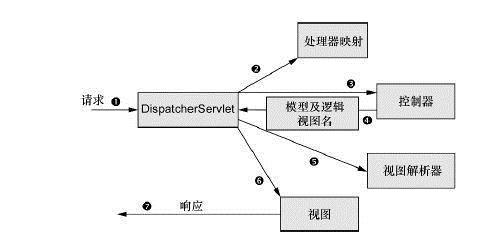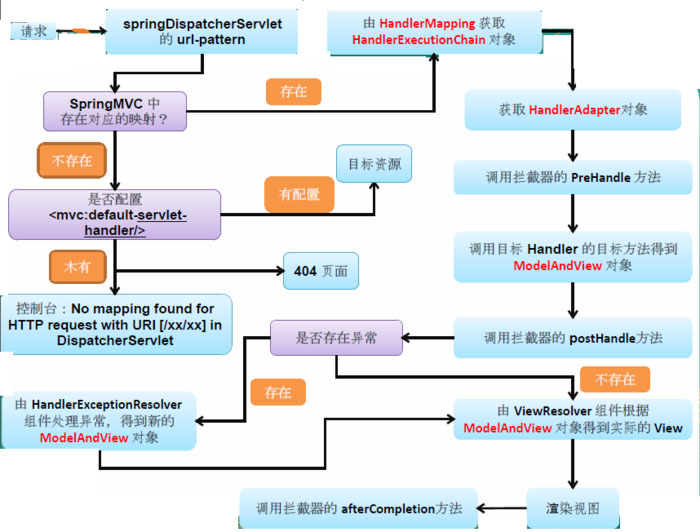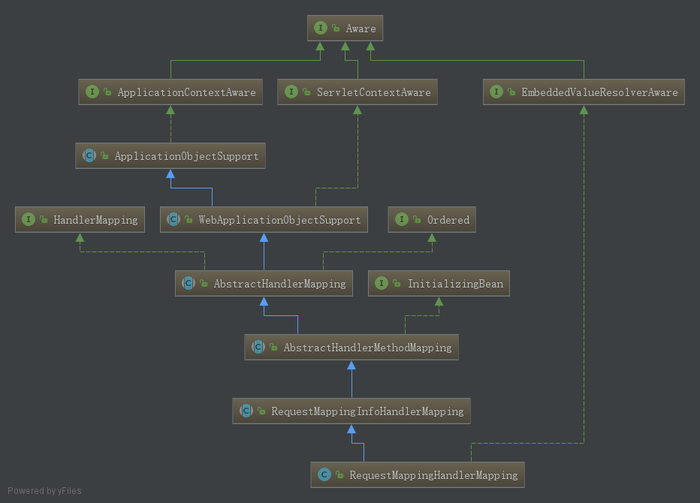0 摘要
本文从源码层面简单讲解springmvc的处理器映射环节,也就是查找controller详细过程
1 springmvc请求流程

controller查找在上图中对应的步骤1至2的过程

springmvc详细运行流程图
2 springmvc初始化过程
2.1 先认识两个类
1.requestmappinginfo
封装requestmapping注解
包含http请求头的相关信息
一个实例对应一个requestmapping注解
2.handlermethod
封装controller的处理请求方法
包含该方法所属的bean对象、该方法对应的method对象、该方法的参数等

requestmappinghandlermapping的继承关系
在springmvc初始化的时候
首先执行requestmappinghandlermapping的afterpropertiesset
然后进入abstracthandlermethodmapping的afterpropertiesset
这个方法会进入该类的inithandlermethods
负责从applicationcontext中扫描beans,然后从bean中查找并注册处理器方法
|
1
2
3
4
5
6
7
8
9
10
11
12
13
14
15
16
17
|
//scan beans in the applicationcontext, detect and register handler methods.protected void inithandlermethods() { ... //获取applicationcontext中所有的bean name string[] beannames = (this.detecthandlermethodsinancestorcontexts ? beanfactoryutils.beannamesfortypeincludingancestors(getapplicationcontext(), object.class) : getapplicationcontext().getbeannamesfortype(object.class)); //遍历beanname数组 for (string beanname : beannames) { //ishandler会根据bean来判断bean定义中是否带有controller注解或requestmapping注解 if (ishandler(getapplicationcontext().gettype(beanname))){ detecthandlermethods(beanname); } } handlermethodsinitialized(gethandlermethods());} |

requestmappinghandlermapping#ishandler
上图方法即判断当前bean定义是否带有controlller注解或requestmapping注解
如果只有requestmapping生效吗?不会的!
因为这种情况下spring初始化的时候不会把该类注册为spring bean,遍历beannames时不会遍历到这个类,所以这里把controller换成compoent也可以,不过一般不这么做
当确定bean为handler后,便会从该bean中查找出具体的handler方法(即controller类下的具体定义的请求处理方法),查找代码如下
|
1
2
3
4
5
6
7
8
9
10
11
12
13
14
15
16
17
18
19
20
21
22
23
24
25
26
27
28
29
30
31
32
33
34
|
/** * look for handler methods in a handler * @param handler the bean name of a handler or a handler instance */protected void detecthandlermethods(final object handler) { //获取当前controller bean的class对象 class<?> handlertype = (handler instanceof string) ? getapplicationcontext().gettype((string) handler) : handler.getclass(); //避免重复调用 getmappingformethod 来重建 requestmappinginfo 实例 final map<method, t> mappings = new identityhashmap<method, t>(); //同上,也是该controller bean的class对象 final class<?> usertype = classutils.getuserclass(handlertype); //获取当前bean的所有handler method //根据 method 定义是否带有 requestmapping //若有则创建requestmappinginfo实例 set<method> methods = handlermethodselector.selectmethods(usertype, new methodfilter() { @override public boolean matches(method method) { t mapping = getmappingformethod(method, usertype); if (mapping != null) { mappings.put(method, mapping); return true; } else { return false; } } }); //遍历并注册当前bean的所有handler method for (method method : methods) { //注册handler method,进入以下方法 registerhandlermethod(handler, method, mappings.get(method)); } |
以上代码有两个地方有调用了getmappingformethod
使用方法和类型级别requestmapping注解来创建requestmappinginfo
|
1
2
3
4
5
6
7
8
9
10
11
12
13
14
15
16
17
18
|
@overrideprotected requestmappinginfo getmappingformethod(method method, class<?> handlertype) {requestmappinginfo info = null;//获取method的@requestmappingrequestmapping methodannotation = annotationutils.findannotation(method, requestmapping.class);if (methodannotation != null) { requestcondition<?> methodcondition = getcustommethodcondition(method); info = createrequestmappinginfo(methodannotation, methodcondition); //获取method所属bean的@requtestmapping注解 requestmapping typeannotation = annotationutils.findannotation(handlertype, requestmapping.class); if (typeannotation != null) { requestcondition<?> typecondition = getcustomtypecondition(handlertype); //合并两个@requestmapping注解 info = createrequestmappinginfo(typeannotation, typecondition).combine(info); }}return info;} |
这个方法的作用就是根据handler method方法创建requestmappinginfo对象。首先判断该mehtod是否含有requestmpping注解。如果有则直接根据该注解的内容创建requestmappinginfo对象。创建以后判断当前method所属的bean是否也含有requestmapping注解。如果含有该注解则会根据该类上的注解创建一个requestmappinginfo对象。然后在合并method上的requestmappinginfo对象,最后返回合并后的对象。现在回过去看detecthandlermethods方法,有两处调用了getmappingformethod方法,个人觉得这里是可以优化的,在第一处判断method时否为handler时,创建的requestmappinginfo对象可以保存起来,直接拿来后面使用,就少了一次创建requestmappinginfo对象的过程。然后紧接着进入registerhandlermehtod方法,如下
|
1
2
3
4
5
6
7
8
9
10
11
12
13
14
15
16
17
18
19
20
21
22
|
protected void registerhandlermethod(object handler, method method, t mapping) { //创建handlermethod handlermethod newhandlermethod = createhandlermethod(handler, method); handlermethod oldhandlermethod = handlermethods.get(mapping); //检查配置是否存在歧义性 if (oldhandlermethod != null && !oldhandlermethod.equals(newhandlermethod)) { throw new illegalstateexception("ambiguous mapping found. cannot map '" + newhandlermethod.getbean() + "' bean method \n" + newhandlermethod + "\nto " + mapping + ": there is already '" + oldhandlermethod.getbean() + "' bean method\n" + oldhandlermethod + " mapped."); } this.handlermethods.put(mapping, newhandlermethod); if (logger.isinfoenabled()) { logger.info("mapped \"" + mapping + "\" onto " + newhandlermethod); } //获取@requestmapping注解的value,然后添加value->requestmappinginfo映射记录至urlmap中 set<string> patterns = getmappingpathpatterns(mapping); for (string pattern : patterns) { if (!getpathmatcher().ispattern(pattern)) { this.urlmap.add(pattern, mapping); } }} |
这里t的类型是requestmappinginfo。这个对象就是封装的具体controller下的方法的requestmapping注解的相关信息。一个requestmapping注解对应一个requestmappinginfo对象。handlermethod和requestmappinginfo类似,是对controlelr下具体处理方法的封装。先看方法的第一行,根据handler和mehthod创建handlermethod对象。第二行通过handlermethods map来获取当前mapping对应的handlermethod。然后判断是否存在相同的requestmapping配置。如下这种配置就会导致此处抛
invocation of init method failed; nested exception is java.lang.illegalstateexception: ambiguous mapping found. cannot map...
异常
|
1
2
3
4
5
6
7
8
9
10
11
12
13
14
|
@controller@requestmapping("/ambiguoustest")public class ambiguoustestcontroller { @requestmapping(value = "/test1") @responsebody public string test1(){ return "method test1"; } @requestmapping(value = "/test1") @responsebody public string test2(){ return "method test2"; }} |
在spingmvc启动(初始化)阶段检查requestmapping配置是否有歧义,这是其中一处检查歧义的(后面还会提到一个在运行时检查歧义性的地方)。然后确认配置正常以后会把该requestmappinginfo和handlermethod对象添加至handlermethods(linkedhashmap)中,静接着把requestmapping注解的value和reuqestmappinginfo对象添加至urlmap中。
registerhandlermethod方法简单总结
该方法的主要有3个职责
1. 检查requestmapping注解配置是否有歧义。
2. 构建requestmappinginfo到handlermethod的映射map。该map便是abstracthandlermethodmapping的成员变量handlermethods。linkedhashmap。
3. 构建abstracthandlermethodmapping的成员变量urlmap,multivaluemap。这个数据结构可以把它理解成map>。其中string类型的key存放的是处理方法上requestmapping注解的value。就是具体的uri
先有如下controller
|
1
2
3
4
5
6
7
8
9
10
11
12
13
14
15
16
17
18
19
20
21
|
@controller@requestmapping("/urlmap")public class urlmapcontroller { @requestmapping(value = "/test1", method = requestmethod.get) @responsebody public string test1(){ return "method test1"; } @requestmapping(value = "/test1") @responsebody public string test2(){ return "method test2"; } @requestmapping(value = "/test3") @responsebody public string test3(){ return "method test3"; }} |
初始化完成后,对应abstracthandlermethodmapping的urlmap的结构如下

以上便是springmvc初始化的主要过程
查找过程
为了理解查找流程,带着一个问题来看,现有如下controller
|
1
2
3
4
5
6
7
8
9
10
11
12
13
14
15
16
17
18
19
20
21
22
23
24
25
26
27
28
|
@controller@requestmapping("/lookuptest")public class lookuptestcontroller { @requestmapping(value = "/test1", method = requestmethod.get) @responsebody public string test1(){ return "method test1"; } @responsebody public string test2(){ return "method test2"; } @requestmapping(value = "/test1", params = "id=1") @responsebody public string test3(){ return "method test3"; } @requestmapping(value = "/*") @responsebody public string test4(){ return "method test4"; }} |
有如下请求

这个请求会进入哪一个方法?
web容器(tomcat、jetty)接收请求后,交给dispatcherservlet处理。frameworkservlet调用对应请求方法(eg:get调用doget),然后调用processrequest方法。进入processrequest方法后,一系列处理后,在line:936进入doservice方法。然后在line856进入dodispatch方法。在line:896获取当前请求的处理器handler。然后进入abstracthandlermethodmapping的lookuphandlermethod方法。代码如下
|
1
2
3
4
5
6
7
8
9
10
11
12
13
14
15
16
17
18
19
20
21
22
23
24
25
26
27
28
29
30
31
32
33
34
35
36
37
38
39
40
|
protected handlermethod lookuphandlermethod(string lookuppath, httpservletrequest request) throws exception { list<match> matches = new arraylist<match>(); //根据uri获取直接匹配的requestmappinginfos list<t> directpathmatches = this.urlmap.get(lookuppath); if (directpathmatches != null) { addmatchingmappings(directpathmatches, matches, request); } //不存在直接匹配的requetmappinginfo,遍历所有requestmappinginfo if (matches.isempty()) { // no choice but to go through all mappings addmatchingmappings(this.handlermethods.keyset(), matches, request); } //获取最佳匹配的requestmappinginfo对应的handlermethod if (!matches.isempty()) { comparator<match> comparator = new matchcomparator(getmappingcomparator(request)); collections.sort(matches, comparator); if (logger.istraceenabled()) { logger.trace("found " + matches.size() + " matching mapping(s) for [" + lookuppath + "] : " + matches); } //再一次检查配置的歧义性 match bestmatch = matches.get(0); if (matches.size() > 1) { match secondbestmatch = matches.get(1); if (comparator.compare(bestmatch, secondbestmatch) == 0) { method m1 = bestmatch.handlermethod.getmethod(); method m2 = secondbestmatch.handlermethod.getmethod(); throw new illegalstateexception( "ambiguous handler methods mapped for http path '" + request.getrequesturl() + "': {" + m1 + ", " + m2 + "}"); } } handlematch(bestmatch.mapping, lookuppath, request); return bestmatch.handlermethod; } else { return handlenomatch(handlermethods.keyset(), lookuppath, request); }} |
进入lookuphandlermethod方法,其中lookuppath="/lookuptest/test1",根据lookuppath,也就是请求的uri。直接查找urlmap,获取直接匹配的requestmappinginfo list。这里会匹配到3个requestmappinginfo。如下

然后进入addmatchingmappings方法
|
1
2
3
4
5
6
7
8
|
private void addmatchingmappings(collection<t> mappings, list<match> matches, httpservletrequest request) { for (t mapping : mappings) { t match = getmatchingmapping(mapping, request); if (match != null) { matches.add(new match(match, handlermethods.get(mapping))); } }} |
这个方法的职责是遍历当前请求的uri和mappings中的requestmappinginfo能否匹配上,如果能匹配上,创建一个相同的requestmappinginfo对象。再获取requestmappinginfo对应的handlermethod。然后创建一个match对象添加至matches list中。执行完addmatchingmappings方法,回到lookuphandlermethod。这时候matches还有3个能匹配上的requestmappinginfo对象。接下来的处理便是对matchers列表进行排序,然后获取列表的第一个元素作为最佳匹配。返回match的handlermethod。这里进入requestmappinginfo的compareto方法,看一下具体的排序逻辑。代码如下
|
1
2
3
4
5
6
7
8
9
10
11
12
13
14
15
16
17
18
19
20
21
22
23
24
25
26
27
28
29
30
31
|
public int compareto(requestmappinginfo other, httpservletrequest request) { int result = patternscondition.compareto(other.getpatternscondition(), request); if (result != 0) { return result; } result = paramscondition.compareto(other.getparamscondition(), request); if (result != 0) { return result; } result = headerscondition.compareto(other.getheaderscondition(), request); if (result != 0) { return result; } result = consumescondition.compareto(other.getconsumescondition(), request); if (result != 0) { return result; } result = producescondition.compareto(other.getproducescondition(), request); if (result != 0) { return result; } result = methodscondition.compareto(other.getmethodscondition(), request); if (result != 0) { return result; } result = customconditionholder.compareto(other.customconditionholder, request); if (result != 0) { return result; } return 0;} |
代码里可以看出,匹配的先后顺序是value>params>headers>consumes>produces>methods>custom,看到这里,前面的问题就能轻易得出答案了。在value相同的情况,params更能先匹配。所以那个请求会进入test3()方法。再回到lookuphandlermethod,在找到handlermethod。springmvc还会这里再一次检查配置的歧义性,这里检查的原理是通过比较匹配度最高的两个requestmappinginfo进行比较。此处可能会有疑问在初始化springmvc有检查配置的歧义性,这里为什么还会检查一次。假如现在controller中有如下两个方法,以下配置是能通过初始化歧义性检查的。
|
1
2
3
4
5
6
7
8
9
10
|
@requestmapping(value = "/test5", method = {requestmethod.get, requestmethod.post})@responsebodypublic string test5(){ return "method test5";}@requestmapping(value = "/test5", method = {requestmethod.get, requestmethod.delete})@responsebodypublic string test6(){ return "method test6";} |
现在执行 http://localhost:8080/springmvc-demo/lookuptest/test5 请求,便会在lookuphandlermethod方法中抛
java.lang.illegalstateexception: ambiguous handler methods mapped for http path 'http://localhost:8080/springmvc-demo/lookuptest/test5'异常。这里抛该异常是因为requestmethodsrequestcondition的compareto方法是比较的method数。代码如下
|
1
2
3
|
public int compareto(requestmethodsrequestcondition other, httpservletrequest request) { return other.methods.size() - this.methods.size();} |
什么时候匹配通配符?当通过urlmap获取不到直接匹配value的requestmappinginfo时才会走通配符匹配进入addmatchingmappings方法。
总结
以上就是这篇文章的全部内容了,希望本文的内容对大家的学习或者工作具有一定的参考学习价值,如果有疑问大家可以留言交流,谢谢大家对服务器之家的支持。
原文链接:https://www.jianshu.com/p/9a363c133270















